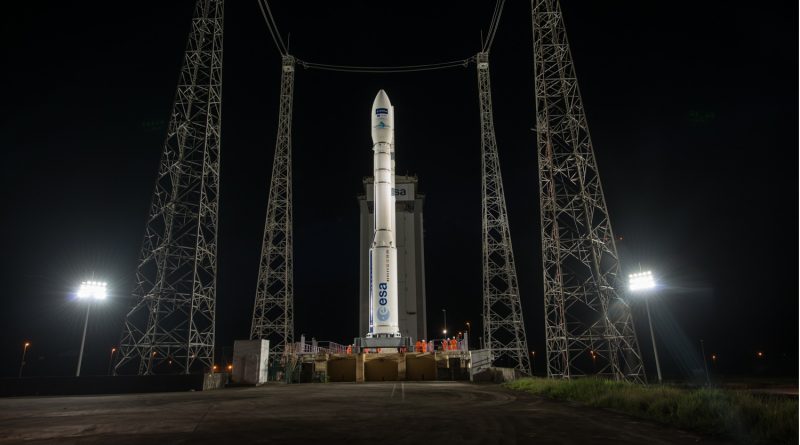Vega Rocket set for Tuesday Night Liftoff with Satellites for Israel, France & Italy
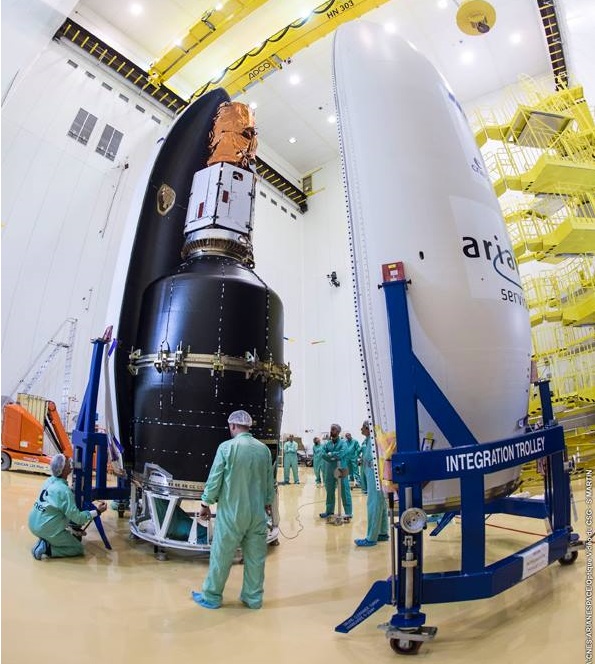
Europe’s Vega rocket stands ready for a nighttime liftoff from the edge of the Amazon jungle Tuesday night carrying a pair of satellites built in Israel for operation by the Italian defence ministry and a French-Israeli cooperation. Vega is targeting liftoff at 1:58:33 UTC on Wednesday and will be in action for 97 minutes to dispatch the two satellites into different orbits – taking advantage of the maneuverability of the rocket’s AVUM upper stage.
Known as VV10 in Arianespace’s numbering system of Vega missions, the flight will be the tenth for the smallest member in the company’s launch vehicle fleet. It will be the eighth Arianespace-operated mission of the year, coming after four heavy-lift missions by Ariane 5, a pair of Soyuz launches to deliver satellites to Geostationary Transfer Orbit and Vega’s VV09 mission that successfully delivered the Sentinel-2B satellite in March for the European Copernicus Program.
Hidden under Vega’s payload fairing for Wednesday’s mission are OPTSAT-3000, riding in the upper position affixed to a Vespa payload adapter, and VENµS that is riding in the lower passenger position for deployment after OPTSAT when the upper stage will have maneuvered into a higher orbit.
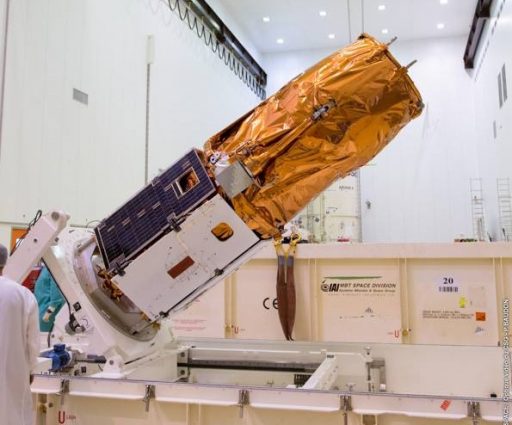
OPTSAT-3000 is a 368-Kilogram image-reconnaissance satellite built by Israel Aerospace Industries for operation by the Italian Ministry of Defence. The satellite was ordered in 2012 in an exchange deal contingent on Israel’s purchase of Italian trainer aircraft. OPTSAT-3000 serves as a gapfiller for the Italian defence authorities until a next-generation space-based platform for the collection of optical reconnaissance will be available.
The 3.4-meter tall OPTSAT-3000 has a single instrument known as Jupiter, a powerful panchromatic and multi-band imaging system fed by a 70-centimeter telescope capable of collecting black and white imagery with a ground resolution of 0.5 meters and color images with a two-meter resolution which can be further improved through PAN-sharpening as both imaging branches can be operated simultaneously. Operating from a 450-Kilometer Sun Synchronous Orbit, OPTSAT-3000 will collect imagery across a 15-Kilometer wide swath, though the craft’s agile pointing system allows imaging at off-nadir angles of up to 30 degrees and quick slew maneuvers can be used to capture multiple targets during a single pass.
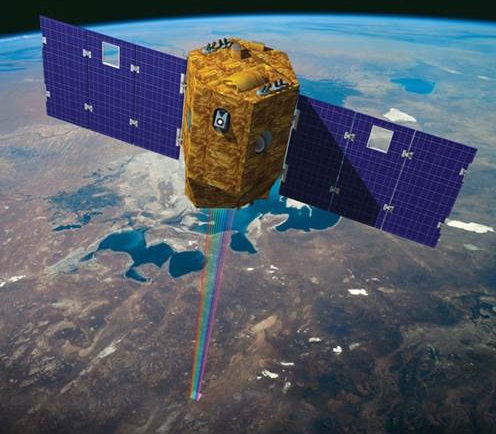
The satellite in the lower passenger position on Wednesday’s flight is VENµS, a 264-Kilogram dual-purpose satellite operated under a cooperation by the French and Israeli Space Agencies. VENµS – the Vegetation and Environment Monitoring New Micro-Satellite – had a long road to launch with the initial agreement between CNES and the Israeli Space Agency Signed in 2005. Under the project, Israel is responsible for manufacture of the satellite bus, the imaging instrument and the mission ground segment while France provides technical assistance, specifications for the instrument and the science ground segment that handles data processing, analysis and distribution.
VENµS, 1.7 meters tall and 1.2 meters in diameter, hosts a 25-centimeter aperture telescope feeding four detector assemblies holding a total of 12 line detectors for imaging in 12 spectral bands at a ground resolution of 5.3 meters. Superspectral imagery collected by the satellite will be used for ecosystem monitoring, capturing imagery of 50 sites that are representative of the world’s inland and coastal ecosystems, providing information on vegetation cover and health and helping in the development for new automated extraction methods to turn satellite data into biosystem parameters. Data from the mission will also be useful for tracing the water and carbon cycles and further the current understand of the interface between land masses and the atmosphere.
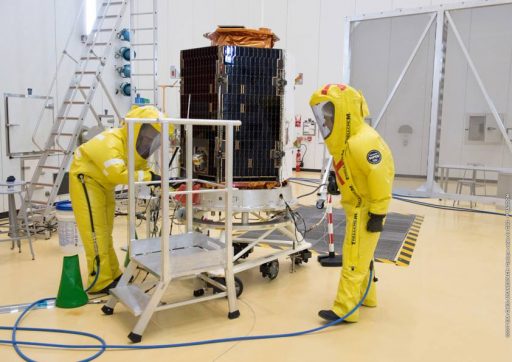
2.5 years are budgeted for the VENµS imaging mission in an orbit of 720 Kilometers before the satellite will enter its second mission phase primarily dedicated to the demonstration of an Israeli Hall Effect Thruster for large orbit changes, orbital maintenance and drag-free flight. To that end, the satellite will employ an autonomous system that calculates the craft’s power budget on an orbit-to-orbit basis to descend from 720 Kilometers into a 410-Kilometer Sun Synchronous Orbit over the course of around half a year, also modifying the orbital inclination to remain in a Sun Synch Orbit.
Once at 410 Kilometers, the satellite will operate the Xenon-fueled Hall Effect Thruster to counter drag and maintain altitude for one year, accumulating a large number of duty cycles and firing time on the thruster to qualify it for operational use on future projects. While at 410 Kilometers, the satellite will alternate between orbital maintenance and operating the super-spectral imager which will achieve a three-meter ground resolution from the lower orbit.
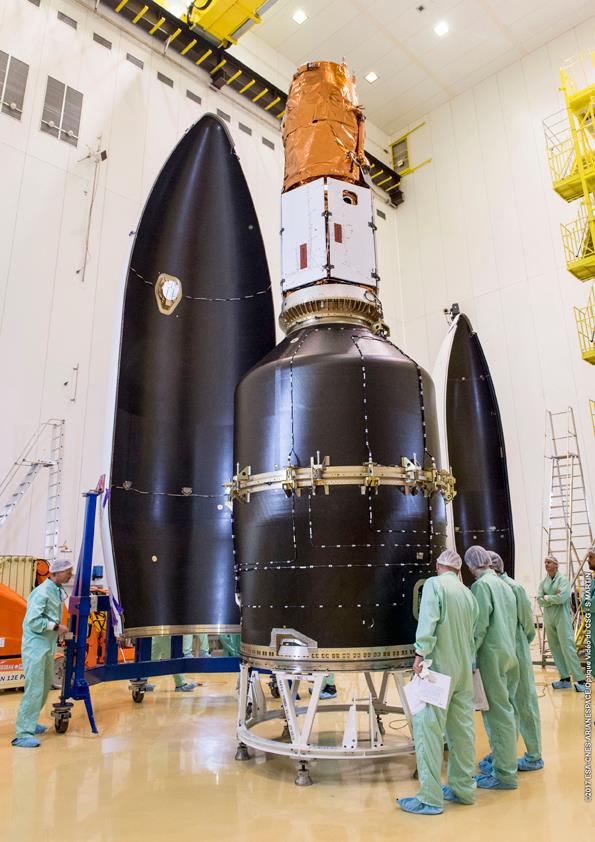
Vega’s VV10 launch campaign began in May with the arrival of the launch vehicle components via one of two sea-going vessels tasked with shipping rocket parts from Europe to the South American launch base. Stacking of the three solid-fueled Vega stages was completed in the second half of June with the AVUM upper stage taking its spot atop the stack in early July.
The two passengers arrived on a Boeing 747 in late June to begin a multi-week preparations flow comprising final tests of the satellites, fueling for flight, and integration of the payload stack with VENµS hidden underneath the Vespa Adapter and the taller OPTSAT sitting atop the stack. Both passengers took their place on the Vega rocket by July 25 for a final set of testing activities leading into the Launch Readiness Review to clear the vehicle for its nighttime liftoff.
With an all-solid rocket and an upper stage carrying storable propellants, Vega will not require any dynamic operations such as propellant loading during its countdown. Countdown operations pick up at T-9 hours and 10 minutes and are largely focused on checks of the rocket’s Multi-Function Unit that is in charge of controlling all aspects of the mission. Both payloads will be on internal power when Vega’s automatic countdown sequence kicks off at T-4 minutes to put the rocket through final reconfigurations for liftoff.
Upon Ignition of its P80 first stage, Vega will literally jump off the ground – generating a total thrust of 280,000 Kilogram-force to lift the 137-metric-ton vehicle. Seconds after lifting off, Vega will pitch over to begin flying to the north, aiming for a Sun Synchronous Insertion.
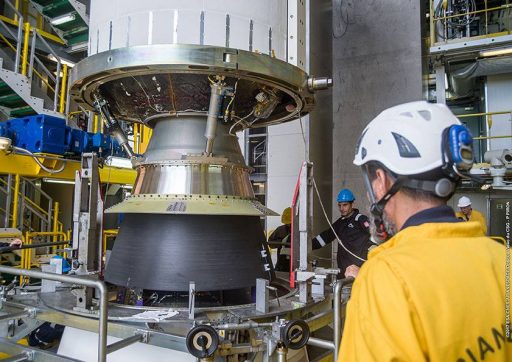
The 11.2-meter long first stage will burn over 88 metric tons of solid propellant in just 115 seconds, accelerating the rocket to a speed of 1.7 Kilometers per second. Burnout on the first stage is sensed by the declining chamber pressure, triggering the pyrotechnic stage separation sequence at T+1:57 to set up for the ignition of the second stage, designated Zefiro-23.
The Z23, loaded with 24 metric tons of packed propellant, will soar to an average thrust of 122 metric-ton-force for a burn of 77 seconds.
Separation of the 8.4-meter second stage is expected at an altitude of 155 Kilometers at a speed of 3.8 Kilometers per second. Ignition of the Zefiro-9 stage comes around 23 seconds after Z23 separation at T+4:03. Although it is the smallest of the three stages, Z9 has the longest burn time – firing for 120 seconds at an average thrust of 23 metric-ton force.
The protective payload fairing will split open and separate four minutes and eight seconds into the flight when Vega will be well on its way out of the dense layers of the atmosphere.
Stage 3 accelerates the vehicle to 7.6 Kilometers per second and separates six minutes and 42 seconds after launch when the vehicle will have reached 236 Kilometers in altitude. At that point, the AVUM – Attitude and Vernier Upper Module – assumes control of the flight, first tasked with stabilizing its orientation before coasting uphill for a little over a minute.
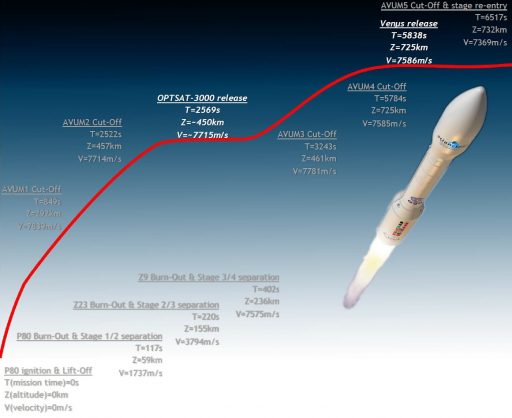
The AVUM will ignite its Main Engine Assembly (RD-869) at T+7 minutes and 52 seconds on a burn of just over six minutes to push the stack into orbit with a thrust of 250 Kilogram-force.
AVUM will be tasked with a relatively complex mission profile on Wednesday calling for a total of five burns the first of which is designed to inject the stack into a Parking Orbit peaking around 450 Kilometers in altitude. In that orbit, the vehicle will coast for half a lap around the planet before lighting up again 40 minutes and 37 seconds into the flight for an 85-second burn to circularize the orbit at 450 Kilometers.
OPTSAT-3000 will be first to depart the vehicle, separating 42 minutes and 49 seconds into the mission to set sail on its imaging mission for the Italian government. AVUM will drop the Vespa adapter ten minutes after OPTSAT separation and re-light the engine at T+53 minutes and 5 seconds on a 58-second burn to lift the high point of the orbit to 720 Kilometers. Then, it’s another half orbit of coasting ahead of a 64-second circularization maneuver at T+95 minutes to set up the proper orbit for VENµS – targeting separation one hour and 37 minutes after liftoff to conclude the primary mission of Vega.
AVUM will be tasked with a 78-second retrograde deorbit maneuver ten minutes after dropping off its second passenger to remove itself from orbit, slowing by 217 meters per second to close out its mission with a fiery re-entry.

